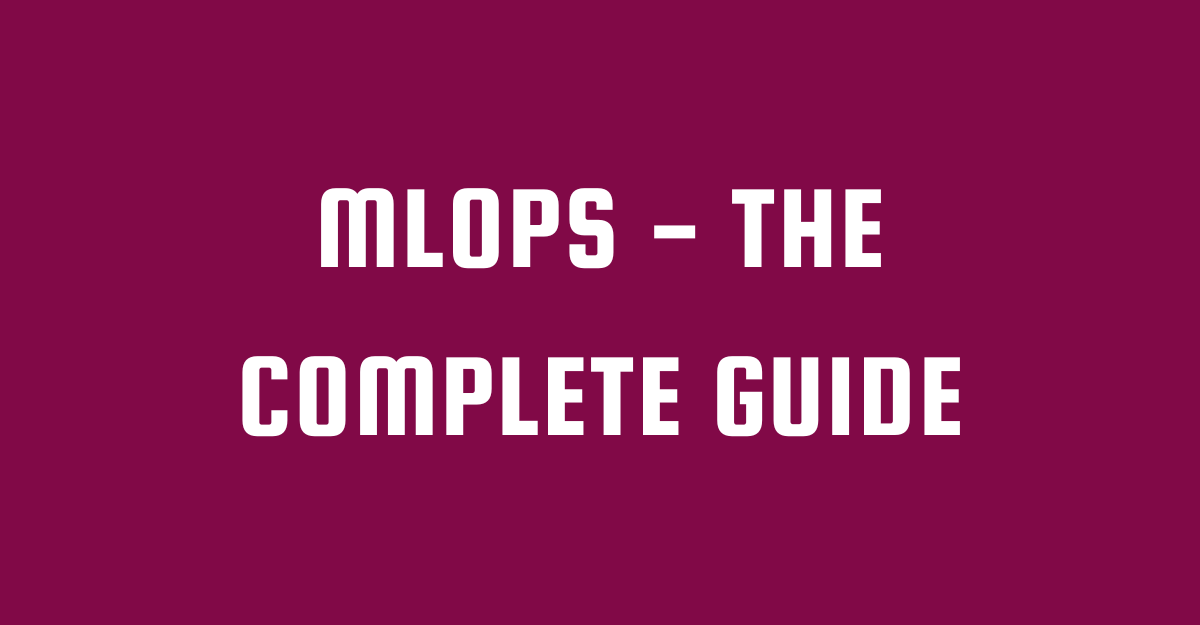
MLOps – The Complete guide
Machine Learning is no more just a technical phrase, its market value has been gradually increasing and reached the value of 105 billion USD in the year 2022. This tech started influencing each and every business sector and paved the way for huge revenue. Obviously, the domination of Machine learning in the tech world would be the prime reason behind the rise of the practice MLOps. In this article, let’s discuss the ins and outs of MLOps.
The first thing I would like you to understand is that MLOps is not an alternative to DevOPs. DevOps is an advanced methodology for SDLC (Software Development Life Cycle) whereas MLOps is designed to train ML models efficiently.
What is MLOps?
MLOps stands for Machine Learning and Operations which comes under ML engineering. The prime purpose of MLOps is to automate and simplify the process of delivering Machine learning models. In layman terms, it is the methodology used for decision automation in the large-scale production and monitoring.
This new ML engineering culture streamlines the function of the entire organization. It is the collaboration platform for everyone in the company like DevOPs engineers, Data Scientists, ML engineers, etc.,
The Key Phases of MLOps are:
- Model training & development
- Model validation
- Model serving
- Model monitoring
- Model re-training.
Why MLOps?
Why you build is more important than what you build. Machine learning is harder than we think. ML life cycle has certain components like model training, model tuning, model deployment, model monitoring, and a lot more. Those are very complex and require the collaboration of experts on all fields in one spot. Generally, it incorporates collaboration, iteration, automation, experimentation and improvements.
Vital Challenges with MLOPs
MLOPs is in its emerging phrases so it does have some challenges to address. it is not a piece of cake, there are some bottlenecks to work it up.
- Machine learning engineers are such a new job profile to the market. The technical skill set needs to be enhanced in all perspectives. This job role might be the intersection of DevOps and Data Science.
- The data is the fuel behind decision automation. though the constant changes with the data patterns would impact the ML model. ML engineers need to maintain the standard of the ML model, govern the AI and train the model with respect to the changing business objectives.
- In some cases, communication gaps become the reason behind the failure of such big projects. MLOps needs to address the common language to act as a medium of collaboration for technical and business teams.
- Risk assessment is also very important. Some methodologies have drifted away from the intent they have raised for.
Common Set of Practices Associated with MLOps
Below listed are the key phases needed to encompass to master the MLOPs.
#Set ML Problems with key business objectives
Everything gets started with a goal and objective of the business. It may be anything from producing 100K of electronic products to generating leads. The objectives need to be clear and precise with KPIs, budget and requirements.
#Architect for the certain objectives
The objectives are transformed into ML problems. The very next step is to look for appropriate data and models specified the certain types of data. Searching and processing data is an associate’s tedious process and multiple steps.
Do the below things to go with the specific data
- Look for similar dataset
- Check the trustworthiness of the data
- Is the data set aligning with GDPR regulations
- Check the accessibility of data
- Check whether the types of sources is static or real-time
- How many times the sources are being used
- How can a data pipeline be created to support model deployment in a production setting as well as training and optimization?
#Process and prepare the Data
This phrase is a part of data engineering. Sort out the features which fit the best for the specified ML problem. To produce clean and compatible data that can be used in the next stage of model development, a comprehensive pipeline must be designed and then coded.
Choosing a performant and economical architecture and cloud service combination is a crucial step in the deployment of such pipelines. AWS S3 and AWS Glue can be used to create data lakes, for instance, if you need to store enormous volumes of data and transfer a lot of it around.
#Model Training
Model Training comes under Data science. model training is the most prominent step. Machine Learning methodology makes decisions based upon the trained model. The initial phrase with training is iterative with a different type of models. You need to put yourself into it and figure out the best solutions with several quantitative measures and mathematics and narrow them down.
This phrase is for experimentation, you need to do a lot and lot of experiments with vast types of data to figure out which model works the best for you.
Other tasks consist of:
- By creating unit tests for model training, you may test a model.
- Compare the model to baselines, easier models, and models across many dimensions.
- Utilize distributed systems, hardware accelerators, and scalable analysis to scale the model training.
#Automate and Build ML Pipelines
To build ML pipelines, consider the following things
- Recognize the system requirements
- Pick up the perfect cloud architecture – hybrid or multi cloud
- Build testing and training pipelines
- Audit how pipeline is running
- Perform data validation
#Model Deployment
When it comes to deployment, there are two types
Static Deployment: The model is bundled into installable application and then deployed
Dynamic Deployment: Here, the model is deployed using a framework or an additional API. In this deployment, one can practice any methods
#Monitor and Maintain the Models
An organization must provide good and equitable governance while monitoring the performance of the models in use. In this context, governance refers to putting in place control methods to ensure that the models fulfil their obligations to all parties, including users, staff, and other stakeholders.
We need data scientists and DevOps engineers to manage the entire system in production throughout this phase by carrying out the following tasks
- Keeping track of model forecasts’ business value and performance degradation.
- Establishing continual evaluation metrics and logging strategies.
- Identifying and fixing bias introduction and system flaws.
- adjusting the model’s performance in the production-ready serving and training pipelines.
How to Implement MLOps ?
For MLOps implementation, there are about three possible methods.
- MLOps Level 0
- MLOps Level 1
- MLOps Level 2
MLOPS Level 0 is the manual process. It is best for the companies those are getting started with Machine Learning. This model is preferable if the model is changed rarely.
MLOps Level 1 is to train the model continuously via ML pipeline automation. Thus, it paved the way for continuous delivery. This implementation is perfect for the organization which has a constantly changing environment.
MLOps Level 2 is appropriate for tech-driven businesses who must retrain their models often, if not hourly, update them in a matter of minutes, and simultaneously redeploy them across thousands of servers. Such enterprises simply cannot function without an end-to-end MLOps cycle.
Cloud Services Offers MLOps Solutions
Top Cloud Solution Providers like AWS, Azure and Google offers Machine learning services. Those are a kind of fully Managed Services that let data scientists and developers build, train and learn ML models quickly. Below listed are some of the suits offered by them.
AWS
- Amazon Sagemaker: To build, monitor, deploy and train ML models.
Azure
- Azure Machine Learning: Build, train and validate ML pipelines
- Azure Pipelines: Automate Machine Learning Deployments
- Azure Monitor: Track metrics
- Azure Kubernetes Services: Offers additional tools
Google Cloud
- Dataflow: to transform, validate, and extract data, and to test models
- AI platform Notebook: To build and train models
- Kuberflow pipelines: To arrange ML deployments
- TFX: Deploy ML Pipelines
Is MLOps the future?
No wonder, In the future AI and Machine learning will dominate the entire tech world for sure. Now MLOps might be in its infant stage but with days it will transform as an inevitable tech giant for sure. If you need any assistance with MLOps, it’s good to get assistance from Cloud Solutions Provider to walk out in a right path.






